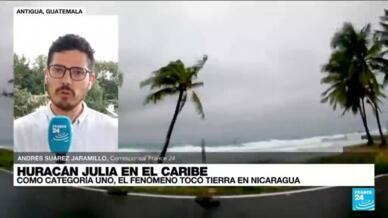Bluefields (Nicaragua) (AFP) – Hurricane Julia made landfall this Sunday on the Caribbean coast of Nicaragua with strong winds and heavy rains and entered its territory, after hitting the Colombian archipelago of San Andrés and Providencia without reporting damage or victims.
“Satellite and radar data from Nicaragua indicate that the center of Julia made landfall in Nicaragua along the coast near Laguna de Perlas” at 0715 GMT on Sunday, the National Hurricane Center posted on its Twitter account.
At the time of impact on land, the winds of the meteor reached 136 km / h, according to the report.
In Bluefields, hurricane-force winds and heavy rains began to be felt around midnight, AFP photographers noted.
There are reports of detached roofs, fallen trees and no electricity in the city, which remains in the dark, according to official media.

After entering the Caribbean, Julia will move through the territory until leaving the Pacific Ocean on Sunday afternoon or night as a tropical storm, according to CNH projections.
Meanwhile, the Colombian archipelago of San Andrés and Providencia, home to some 48,000 people, was battered by Julia’s winds before reaching the Nicaraguan coast, but authorities had reported no significant damage or casualties.
Saving lives in Nicaragua
Before Julia’s arrival, the population of Bluefields stocked up on food and sheltered in their homes, while the fishermen took their boats to a safe place.
“We have to prepare with food, plastics, a little of everything, because we don’t know what is going to happen,” Javier Duarte, a cabinetmaker who has prayed that the cyclone is not powerful in this municipality of around 60,000 inhabitants.
“We have already had some experiences of hurricanes in Nicaragua, and we are likely to experience” a similar situation, said Constantino Rivera, a 47-year-old fisherman who was ordered to return to land.
The government reported that they evacuated more than 6,000 people in Laguna de Perlas, in the Cayos Miskitos, an island located off the Caribbean coast, and other coastal communities.
“This storm has come gradually, but progressively evolving and strengthening,” said the meteorology director of the Nicaraguan Institute for Territorial Studies (Ineter), Marcio Baca.
According to the CNH, Julia will bring rains over the weekend that could cause “flash floods and mudslides” in Central America.
In the face of the emergency, the government National System for Disaster Prevention, Mitigation and Attention (Sinapred) of Nicaragua reported that the army’s rescue units were displaced to risk areas to assist the population, while the police mobilized more than 400 media.
The Ministry of Health, for its part, supplied all the areas that will be affected by the hurricane with medicines, equipment and emergency rooms.

Sinapred also has 91 schools to be used as shelters in the Caribbean region and the southern department of Río San Juan.
“We hope to be ready to safeguard lives, because that is what we prioritize,” said Rosario Murillo, wife of President Daniel Ortega.
Nicaragua expects the rains from Julia to affect the departments of Chontales, Boaco (center), Matagalpa, Estelí, Madriz (north) and Chinandega (northwest), where the soils are saturated and landslides could occur.
Alerts in Central America
Before the arrival of Julia, Colombia and the countries of Central America announced different levels of alert.
In Guatemala, the state Coordinator for Disaster Reduction (Conred), in charge of civil protection, declared a red alert throughout the country on Saturday.
El Salvador declared a state of national emergency on Saturday night and the government will allocate financial and logistical resources to serve the population.
In Panama, the National Civil Protection Service decreed a yellow alert in almost the entire country, including the province of Darién, a jungle area bordering Colombia, where hundreds of migrants pass daily on their way to the United States.
And Honduras was still on yellow alert.

According to the National Meteorological Institute (IMN) of Costa Rica, Hurricane Julia has a very extensive cloud field that could cover all of Central America, covering an area of more than 522,000 km².
Julia is the second hurricane of the 2022 season in the Central American Caribbean, after Bonnie entered the southern Caribbean between the border of Nicaragua and Costa Rica in July and affected hundreds of people in the region.
Climate change produces an increase in temperature in the surface layers of the oceans, which generates more powerful storms and hurricanes and with greater amounts of water, according to experts.







![[Img #74683]](https://thelatestnews.world/wp-content/uploads/2024/12/The-main-mistakes-to-avoid-when-betting-on-electronic-sports-150x150.jpg)






